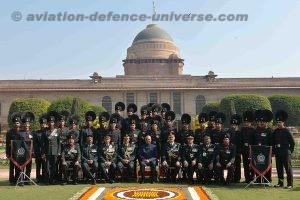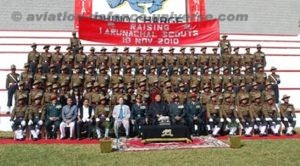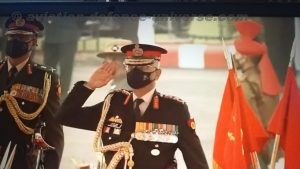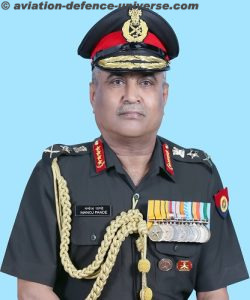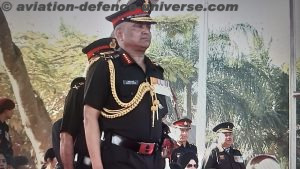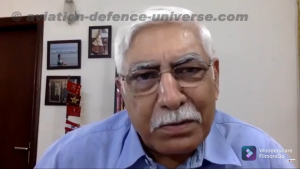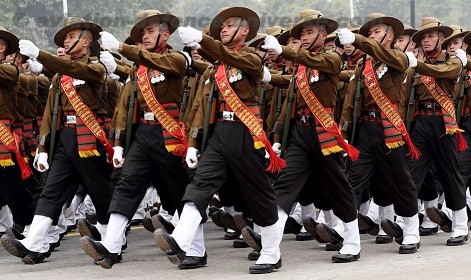
New Delhi. The first Indian Army officer promoted to the rank of the Indian Army Field Marshal Sam Hormusji Framji Jamshedji Manekshaw, of the Gorkha Regiment famously said, “If anyone tells you he is never afraid, he is a liar or he is a Gurkha”.
With the motto “Better to Die than Being a Coward”, the Gorkha epitomizes a soldier with a wide-rimmed slanting hat, carrying the deadly ‘khukuri’ and war cry, “Jai Ma Kali Aayo Gorkhali” on his lips. The ‘Khukri’, a 12 inch knife, is a symbol of pride for Gorkhas. During the Congo War with only the Khukri in his hands, Captain Gurcharan Singh Salaria killed 40 enemies.
No truer words have been spoken of the oldest and the most decorated and dreaded Infantry regiment of the Indian Army.
THE ORIGINS- HISTORY OF GORKHA REGIMENT
Maharaja Ranjit Singh was the first to induct the Gurkhas, into the Sikh Army. The Gurkhas belong to the Himalayan region in Nepal and India. The harsh and difficult terrain makes the stockily built Gurkhas perfect to excel as combat soldiers. The fierce hill men have tremendous fortitude, resilience, and physical prowess.
The British too were impressed by the fighting skills and raised the first Gurkha regiment the 1st King George’s Own Gurkha Rifles. Under the British regime, the Gurkha Regiments kept growing steadily, they saw action in several wars and crushed many rebellions, the most significant one being the Indian Rebellion of 1857.
The courageous and formidable Gurkhas earned many battle honors and by the First World War, there were 11 Gurkha Regiments and about 2 lakh Gorkha soldiers in the British Army.
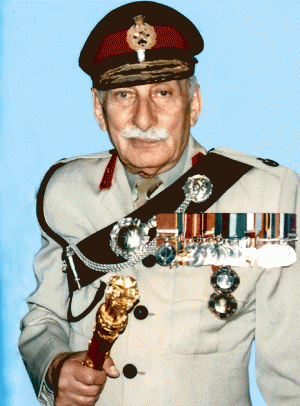
POST-INDEPENDENCE- THE TRIPARTITE TREATY AGREEMENT
In 1947, under the Tripartite agreement between India, United Kingdom and Nepal the original 10 Gorkha Regiments were split, 6 regiments joined the Indian Army, four were transferred to the British Army.
THE GURKHA BRIGADE.
Wielding a khukri in their hand, they present a picture of a fierce almost magical heroes with supernatural powers. The Gurkhas have etched their names in military history of the world. The Gurkha Brigade has participated actively in all of India’s wars and major campaigns.
The regiment has won several gallantry awards, honors and citations other than numerous battles and theatre honors, for their unconquerable daring, undeterred spirit and valor.
Here is a comprehensive list:
- Param Vir Chakra, the highest military decoration: 3
- Ashoka Chakra: 10
- Mahavir Chakra: 30
- Kirti Chakra: 13
- Vir Chakra: 99
- Shaurya Chakra: 44
- Sena Medal: 201
- Uttam Yudh Seva Medal: 1
- Yudh Seva Medal: 5
- Param Vishisht Seva Medal: 23
- Ati Vishisht Seva Medal: 32
- Vishisht Seva Medal: 55
- Padma Bhushan: 2
- Padma Vibhushan: 1
PRESENT DAY STRENGTH
There are 39 battalions serving in 7 Gorkha regiment. The Gurkha Rifles regiment are collectively called ‘The Gorkha Brigade”. This is the breakdown.
- 1 Gorkha Rifles, made up of 5 battalions
- 3 Gorkha Rifle with 5 battalions
- 4 Gurkha Rifles with 5 battalions
- 5 Gorkha Rifles with 6 battalions
- 8 Gurkha Rifles 6 battalions
- 9 Gurkha Rifles 6 battalions
- 11 Gurkha Rifles 7 battalions
GORKHA REGIMENTAL CENTERS
There are four Regimental Training Centers situated all over India.
- 11 Gorkha Rifles Regimental Centre, Lucknow, Uttar Pradesh
- 14 Gorkha Training Center Sabathu, Himachal Pradesh
- 39 Gorkha Training Cerntre Located in Varanasi, Uttar pradesh
- 58 Gorkha Training Centre, Happy Valley. Shillong , Meghalaya
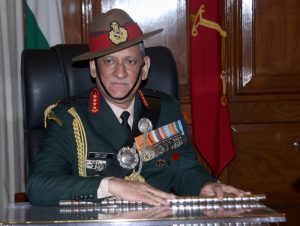
THE MANY FIRSTS AND UNIQUE DISTINCTIONS AND ACTS:
- 11 Gorkha Rifles is the most decorated platoon of the Indian Army.
- The first Field Marshal loving called Sam Bahadur- ‘Sam the Brave’ was a Gurkha. He is considered to be India’s greatest military strategist and commander till date.
- It has produced three army chiefs, the most from any regiment.
- General Bipin Rawat of Gurkhas is the First Chief of Defence Staff.
- The regiment is 212 years young.
- They are the most feared soldiers of the planet and even the enemy respect their competencies.
- During The Kargil War, the Gurkha soldiers ran out of ammunition, still they advanced towards the enemy with the war cry on their lips and ‘khukri’ in hands and beat back the Pakistani Army.
- It is the deadliest regiment of the Indian Army
- The Gurkha Regiment is named after the hill town of Gorkha in Nepal.
- The 11th Gorkha Regiment was raised when a large number of soldiers from the 7th and 10th Gorkha decided to join the Indian Army instead of the British army.
- Even the Queen has two personal Gurkha officers.
- The Gorkhas are also a part of the UN peacekeeping missions.
- All Non-Gurkhas have to learn Gokhali.
- Each regiment has a different custom of wearing the head gear. The slanting hat is worn by 5 Gorkha Regiment below the lower lip whereas other units wear it below the jaw.
The freedom and protection we enjoy is because of these valiant soldiers and martyrs of the Indian Army standing courageously on the line of control.
The recent Mi17-V5 crash saw the tragic demise of three Gorkhas India will always remember. The CDS General Bipin Rawat, Lt. Col Harjinder Singh & Havaldar Satpal Rai.





































